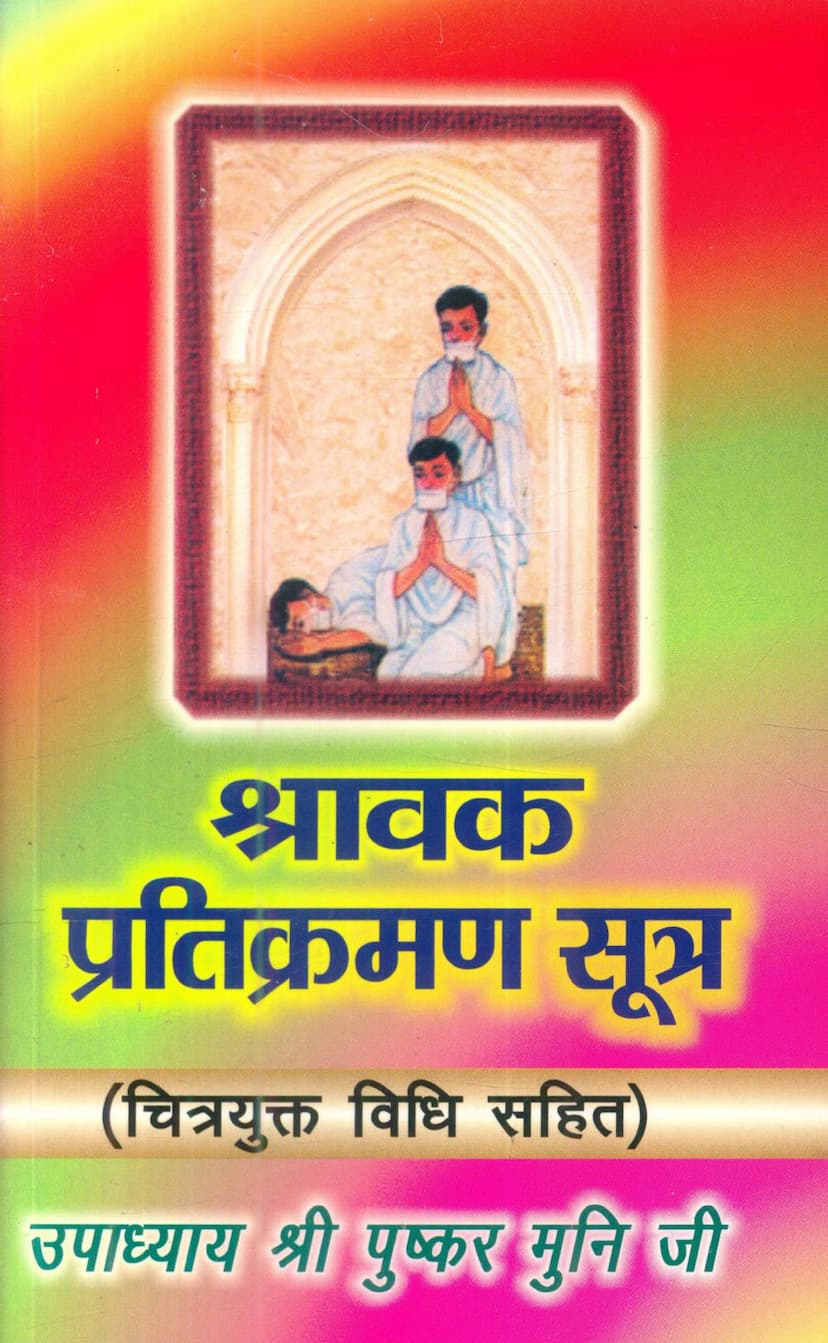Shravak Pratikraman Sutra
Added to library: September 2, 2025

Summary
This is a comprehensive summary of the "Shravak Pratikraman Sutra" by Upadhyay Shri Pushkarmuni, published by Shri Tarak Guru Jain Granthalay, Udaipur.
Overall Purpose and Significance:
The "Shravak Pratikraman Sutra" is a foundational text in Jainism, specifically for lay followers (Shravaks and Shravikas). It details the practices of Pratikraman, which translates to "repentance" or "reflection" and is a crucial ritual for acknowledging and rectifying any transgressions or lapses in spiritual practice. The book emphasizes the importance of introspection and self-purification in the materialistic modern age, where people tend to stray from spiritual values.
Key Concepts Explained:
- The Importance of Pratikraman in Jainism: The text begins by highlighting the current materialistic era and humanity's drift away from spiritualism, embracing materialism over spirituality, violence over non-violence, and accumulation over non-possession. It asserts that Jain philosophy encourages introspection (Antardarshan) and any practice that doesn't lead to introspection is not true practice but rather a violation (Viradhana). Pratikraman is presented as an essential practice for self-improvement, a means to shed negative qualities and embrace virtues, and to conquer the senses and passions.
- The Six Avashyakas (Essential Duties): The book explains the sequence and significance of the six essential daily duties for a Jain practitioner:
- Samayik: Cultivating equanimity and mental balance.
- Chaturvishthti-sthav: Praising the Tirthankaras (24 Jinas).
- Vandan: Showing respect and bowing to spiritual preceptors.
- Pratikraman: Critically examining and repenting for one's faults.
- Kayotsarg: Detaching oneself from the body's needs and distractions.
- Pratyakhyan: Renouncing certain foods or activities. The text emphasizes that this sequence is based on a cause-and-effect relationship, leading to spiritual growth.
- The Meaning of Pratikraman: It clarifies that Pratikraman means returning to righteous conduct (Shubha Yoga) after deviating into unrighteous conduct (Ashubha Yoga), and continually engaging in increasingly virtuous actions. It's a process of overcoming the four major faults: false belief (Mithyatva), non-abstinence (Avirati), passions (Kashaya), and unwholesome actions (Apraushast Yoga).
- Types of Pratikraman: The book mentions various classifications of Pratikraman:
- By time: Daily (Daivasik), Nightly (Rātrik), Fortnightly (Paakshik), Four-monthly (Chaturmāsik), and Yearly (Sānvatsarik).
- By time of action: Repenting for past faults, achieving liberation from present faults through restraint, and making vows for future prevention.
- By nature: Dravya Pratikraman (reciting texts mechanically without understanding) and Bhava Pratikraman (internalizing the meaning and practicing it). Bhava Pratikraman is highlighted as the true essence of the practice.
- Repetitions in Pratikraman: The text addresses the common question about repetitions in the texts, explaining that repetition is not a fault in this context. Instead, it serves as reinforcement, emphasis, and aids in memory and contemplation.
- Timing of Pratikraman: It details the appropriate times for performing different types of Pratikraman, such as daily at the end of the day and night, fortnightly at the end of a fortnight, and so on.
- Universality of Pratikraman: It dispels the misconception that Pratikraman is only for those who have taken twelve vows. It is beneficial for all Jain followers, regardless of their vow status, as it facilitates self-inspection and strengthens devotion to vows.
- Analogy of Pratikraman: Pratikraman is likened to medicine that heals illness, or even beneficial when taken without illness, strengthening the body and mind.
Practical Guidance and Structure:
The book provides a detailed, step-by-step guide on how to perform the Pratikraman ritual. It includes:
- Illustrations: The "चित्रयुक्त विधि सहित" (with illustrated method) in the title indicates that the book incorporates images to visually guide the practitioner through the various postures and actions.
- Specific Prayers and Mantras: It lists the exact verses and mantras to be recited, starting with the Namaskar Mantra, followed by Samayik Sutra, Chaturvishthti-sthav, Vandan Sutra, Pratikraman Sutra (which includes detailed repentance for various transgressions), Kayotsarg (with Agar Sutra and Doshaapahaar Sutra), and Pratyakhyan (renunciation vows).
- Detailed Breakdown of Faults (Aticharas): A significant portion of the book is dedicated to listing and explaining numerous faults (Aticharas) related to:
- Knowledge (14 types)
- Right Faith (Samyaktva) (5 types)
- The Twelve Vows of a Shravak (60 types, with specific examples for each)
- Unethical occupations (Karma-adanas)
- Unjustified actions (Anarthadand)
- Samayik, Deshavakashik, Paushadh, and Atithi-samvibhag vows.
- Sanlekhana (death-bed preparation)
- The Eighteen Deadly Sins (Ashtadash Paapasthanak) The detailed enumeration of these faults allows the practitioner to precisely identify and repent for their specific shortcomings.
- Guru-Vandan and Seeking Permission: The text emphasizes the importance of seeking permission from the spiritual preceptor (Guru) before commencing and concluding specific parts of the ritual.
- Concluding Prayers and Forgiveness: The ritual concludes with prayers for forgiveness, seeking blessings, and expressing respect for the entire Jain monastic community (Sangha) and all living beings.
Unique Features of This Edition:
- Comprehensive Editing: Edited by Upadhyay Gurudev Shri Pushkar Muni Ji Maharaj.
- Guidance from Acharya Shri Devendra Muni Ji: The book features guiding words from Acharya Shri Devendra Muni Ji.
- Previous Editions: The text notes that previous editions have been popular, with over 20,000 copies distributed, indicating its significance.
- Illustrations: The inclusion of illustrations makes the practice more accessible, especially for new practitioners.
- Systematic Presentation: The text is presented in a clear and organized manner, with verses and explanations placed together for ease of understanding and recitation.
- Affordable Pricing: The book is offered at half its cost price, making it accessible to a wider audience.
In essence, the "Shravak Pratikraman Sutra" serves as a practical manual and a spiritual guide for Jain lay followers, enabling them to purify their conduct, strengthen their spiritual resolve, and progress on the path of liberation through diligent self-reflection and repentance.